
14 minute read
Participatory Workshop
by 木子蘋
Summary
Based on the findings from the probes, informances, and some reading on the Social Comparison theory, we designed a cohesive workshop in the spirit of Participatory Design, an emerging design practice that involves different non-designers in various co-design activities throughout the design process to explore potentials for design on feelings of isolation and pressure from the Internet. The workshop leads participants from reflective writing, to physical activities that release pressure, to emotional expression and roleplay by conducting multiple activities. The workshop was held on October 22, from 7:00PM-9:30PM in V701 of the Innovation Tower in the Hong Kong Polytechnic University. The total process lasted for 2.5 hours.
Advertisement
In contrast to our cultural probes and informances, where we used divergent methods to study the matter, the participatory workshop was designed to be highly focused and convergent.
Goals
- Gain an understanding of what causes social pressure in adults - Know how people express themselves - Know what people would do when they feel lonely - Involve participants act out an experience of conflict based on their own sharing and observe the ways they overcome the conflict.
Roles of the Team
Tata Yap: Facilitator Molly Lee: Helper, Yoga Facilitator Allen Xie: Video Recorder Fish Zhang: Note Taker
Working Process
Pilot Testing -> Pre-workshop -> Workshop Proper
Pilot Testing
We invited 1-2 students in our class to pilot testing, in order to get feedback and improvements.
Our pilot tester suggested that we cancel one very difficult yoga movement since he felt uncomfortable when doing it. When asked about diary sharing, he said he did not feel awkward when another person was reading his personal story. We confirmed that people may not react so negatively when their deep thoughts are said out loud.
The pilot tester also suggested some labelling changes in the User Journey Map: “touchpoints” and “what” into “Where” and “What can help”, which would be easier to understand. He also suggested adding some more time to do the roleplay.
Pre-Workshop
We sent the questions of the workbook to the participants so that they can think about the stories in advance and send us. - Describe yourself - What is your hobby? - A problem you are facing right now? - What made you feel stressful, lonely or anxious these days? - Does the feeling have any impact on you? If yes,what is the impact? - How did you cope with it?
Workshop Proper Activities:
Participants
The participants are 4 male and 1 female aged 29-35, who are postgraduate students or staff, each of them come from different countries. Most of them feel the anxiety of Internet and social media from time to time. During the workshop they were divided into 2 groups for team-work.

Schedule
Figure 16 Workshop Schedule
Activity 1 : Diary Writing

Figure 17
Diary writing and collected diaries

Description
Before starting activities, each of the participants need to complete the questions on the diary sheet within 10 minutes. Since we have sent the questions by online message a day before the workshop, the participants have already thought about it before they come. The questions are about their experiences of loneliness and self-reflection.
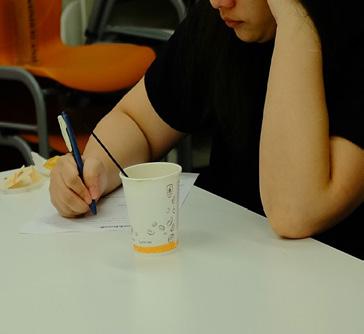
Purpose
The diary sheets are fundamental to the following activities of the workshop. When people concentrate on writing, it is also a way to help them to calm down and immerse themselves into the atmosphere we created. We put on soft music and specifically instructed them to not write their names on the sheets, to preserve their identities and to make it comfortable for everyone to read their experiences out loud.
Activities 2: Icebreaker Yoga
Figure 18
Yoga exercises

Description
We moved all the objects to the side of the venue to keep the center empty. Participants were asked to form pairs to do partner stretching together. We made sure that they were partnered with someone they did not know so well. They followed the instructions from the facilitator who also demonstrated the pose. There were four stretching poses ranging from easy to difficult, participants were allowed to skip any of the poses if they felt uncomfortable.
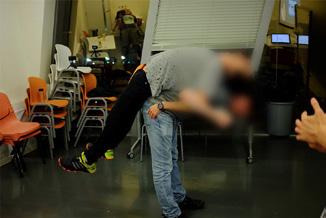
Purpose
Most of the participants didn’t know each other very well before taking part in the workshop. The yoga exercise is designed to break the physical and metaphorical barrier among participants. It is said that the more interaction with body movement the more connection between people would be built. Stretching can warm-up and relax tensions in the body— something we specifically intended as our study has something to do with the concept of pressure.
Results
Surprisingly, the more difficult poses get more reactions and responses from them. We noticed that they quickly felt relaxed and chattier after. Even the pose we planned to cancel from the pilot testing was willingly done by the participants.
Activities 3: Diary Sharing
Figure 19
Diary sharing scenes

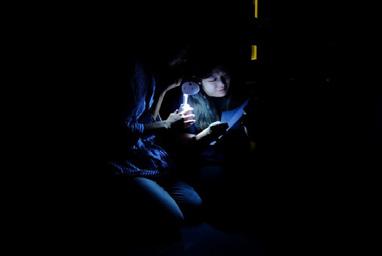
Description
To encourage people to tell the stories from the depths of their hearts, we tried to create a meditation space where was dedicated to silence and stillness. We turned off the lights to keep surrounding completely dark and played soft music in the background. Then, participants were asked to read out the diary sheet they picked randomly and give some personal advice to the anonymous writer afterwards when facilitator held the lamp approaching them. After all the stories had been shared they had a lengthy discussion about the topic they resonate with.
Purpose
The intention of activities is to get an insight of where their pressure and loneliness come from as well as an inspiration of the scenario for the next activities. This activity was designed to externalize their problems and have it be read by another person. The intention was to introduce a new sense of perspective. The darkness and silence, akin to a meditation space is also a way to help them release pressure and gain more self-reflection.
Results
We organized and synthesized the problems they had the most and realized that even if each of them came from different countries and different backgrounds, the obstacles they faced were quite similar: feeling anxious and stressed about school work, facing difficult relationship and language problems as a foreigner, and time management. Most of them spoke easily and candidly as they related to each others’ problems because the same thing happens to them as well.
Food and Refreshment Break: Rapid Scenario Writing
Purpose
Another key moment in the workshop was when we rapidly synthesized the six (6) experiences from the diary sharing into two (2) distinct scenarios that contained bits and pieces of everyone’s sharings. We intended to represent a facet of each and everyone’s problems into the two scenarios so that they could recall and recognize their own contribution to the scenarios.
These scenarios were written in preparation for the next activity where two groups would map out one scenario each in a journey map.
The two prompt scenarios rapidly generated during the break:
Scenario 1
I’m the youngest in the family and my parents have a lot of expectations from me because I studied the most and was always in the honor roll. I am currently a foreign student, have leadership positions in some organizations as well as representative of the class. I have a part-time job to manage my finances and I feel very anxious every day. One day I was presenting a project I worked really hard, but was ridiculed very harshly by my professor in front of the whole class. I see my classmates posting their projects online on IG and I just wanted to throw my phone out of the window. I feel like my reputation is ruined. I have to work even harder to catch up on them.
Scenario 2
I’m working in a field where my colleagues admire and have a lot of regard for me, but it’s a job that requires me to talk to so many people (HR). Most days I just want to rest and not think about anything or even go out of my room but my boyfriend/girlfriend is also expecting me to spend more time with her/him. We’ve been together for just a year but I already feel quite burdened with everything, my parents mentioning marriage and all. I still like him/her, but I just feel very aimless and blah and just want to go with the motions. One day, my boyfriend/girlfriend said he was thinking of breaking up with me.
Activity 4: User Journey Map
Description
We took stories and tried to create a new scenario out of them. The participants were first grouped into 2, one group with 3 members, then they had 30 minutes to map out a “User Journey Map” with their experiences based on the scenario we assigned for them. We also prepared small notes and a diagram to fill out as well as pens for writing. The brief was to simply write anything that came to mind in each of the empty boxes.
The diagram we prepared as following: (Try to imagine the situation in a journey map)
Figure 20
User Journey Map
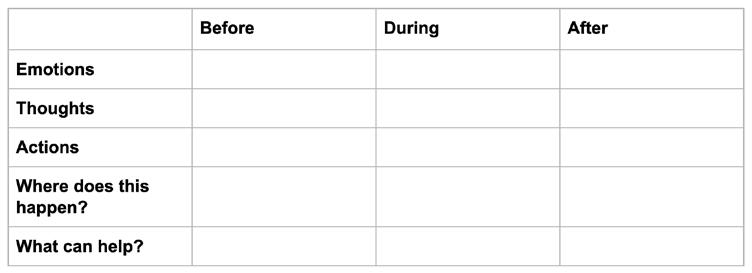
Figure 21
User Journey Map Activity & Results


Purpose
To let participants to map out processes and events, or their understanding of categories or systems for us to further gain insight into specific thoughts and behaviors they may have while embodying a scenario’s protagonist. It was important to break their thoughts down into emotions, thoughts, actions, where, and what, to ignite unique and interesting findings, ultimately preparing them for roleplaying and prototyping.


Results
For scenario 1, The emotional process starts from anxiety - frustration - slowing down. Before - Anxious, insecure about too much being demanded of them, causing a reduced social life. Willing to self-reflect. During- Frustrated and shocked as a mix of anger and inferiority makes me want to seek shelter, shut off and vent to unrelated people. After- Slowing down,becoming more reserved than before. I try to reduce my responsibilities as I seek a fresh start.
There are key findings we got from the map: Social comparison is apparent, a fear of losing role model status. People sometimes feel comforted when facing unrelated people. “Unrelated” people don’t have expectations, so they don’t have to prove something. They feel less stressed.
Fresh Starts — Newness is comfort.
For scenario 2, The emotional process starts from feeling stressed - feelings of giving up - self-reflection. Before- Pressure and frustration make me not want to think anymore and just “turtle”. I need a long vacation or self-analyse. During- Feeling unstable, lonely, and weak make me want to give up. I feel like everyone is looking at me and I want to punch a bag. I want to ask for feedback from friends and family. After- I feel lonely and helpless, keep thinking I made a mistake. I have to stay in a private space to read, watch, and think about what happened.
There are key findings we got from the map:
Loneliness and pressure — Physicality.
There is a visceral factor — sensation of having a shelter, “all eyes looking at me”. Thinking about nothing > thinking good thoughts. People crave blankness in times of trouble. There will be a time for recovery after.
Activity 5: Role-play
Figure 22
Roleplay scenes Activity & Results

Description
The participants were asked to take user journey map and select the most interesting timeframe to enact. Usually, it would cover 2 columns of the map (Before, During, After) and their in-betweens. We also prepared paper, clay, card, scissors, pen, mockups for them to use as props. appreciate your input so feel free to speak as you act. They had 15 minutes for preparation and 2 minutes for role-play.
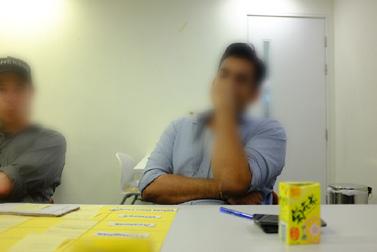
Purpose
This final workshop activity, synthesizes and externalizes all the built-up activities from the participatory workshop. The goal was to see how the participants acted out and used their speech and bodies to depict a situation. With the tools provided (clay, paper, card, scissors, etc), we can see how they used their natural creativity to use items to their benefit. By focusing on acting scenes instead of making “products”
we are able to better observe their behaviours as well as emotions by acting out. From these scenarios we could point our interesting and specific actions that inspired our design vision.
Results
For scenario 1, the role-play was focusing on During and After the stories: A guy felt frustrated and disappointed at school work. While he received a phone call from his friend inviting him to meet unexpected people to show them how good he is on playing the video game. Suddenly he regained his confidence back.
Figure 23
Roleplay scenes Activity & Results Group 1

Here are key findings we got from their behaviours: Rationalizing to prove himself Needing clear answers from the source of problem (teacher). Social pressure to answer calls and messages even if he did not want to. Wanted to “dodge” the invitation, but was not able. “Don’t ask”, not wanting to talk about the problem at all to his friend. A sense of relaxation when new friends compliment him. “Sudden appreciation that is not expected from”
For scenario 2, A guy had a conflict with his girlfriend while he was unable to meet the teacher’s expectations. When he noticed that his girlfriend even want to break the engagement he felt totally burned out and want to turtle himself.
Figure 24
Roleplay scenes Activity & Results Group 2
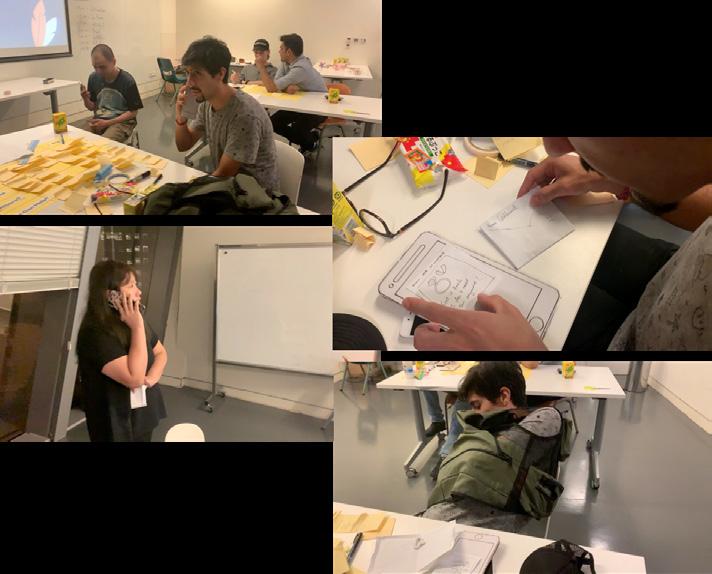
Here are the key findings we got from their behaviours: Girl: “You never think about me” Throw away the phone. They want to hide (physical covering with the vest) “Shelter” Leave phone far away to not listen too clearly. Posting on social media, but with a threshold, they cry for help initially but when they get really bad embarrassing news, they definitely do not share. Stuttering usually happened.
Conclusion
After the roleplay we concluded the workshop by showing our appreciation to all the participants for their participation. Meanwhile, we also asked for some valuable feedback for future improvement.
Participatory Workshop: Insights
There is comfort in physicality and the visceral
Stress is an inevitable part of life, and there are ways to manage our mental pressures by physical and visceral externalization. We tried to manifest this in activities like the icebreaker yoga exercise. Furthermore, in the user journey map one of the participants also mentioned that he felt the need to have a punching bag to do physical exercise when under pressure or anxiety. Another participant mentioned sensation of having a shelter or try to “turtle” himself when coming across frustrating moments, not as a way of giving up, but as a coping mechanism
The effect of the workshop ambiance to our participant is also evidence of the impact of physical states. During the diary sharing activities, we helped them reach a mentally clear and emotionally calm state by keeping the surrounding completely dark and quiet.
The value of newness and fresh starts; no expectations
Another vital insight gained from the workshop is the realization that “newness” plays a key factor in coping with isolation and pressure. For our participants, feelings of loneliness and social pressure oftentimes carry a lot of past baggage. Expectations from the self, family, friends, and society all snowball into an overwhelming weight that our participants find too difficult to bear. A refreshing, unexpected, and new experience gives our participants a momentary respite from all past baggage and helps them gain a new perspective on their problems.
Many of our participants gave us feedback that they appreciated the probes and workshop, as it was an unusual, new activity that gave them time to think about feelings and emotions that they would have otherwise forgotten or ignored.
These insights delightfully mirrors and recalls findings from the earlier probe and informance activities.










